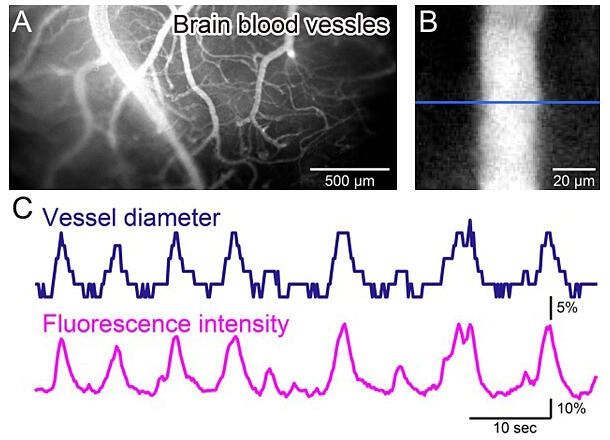Cerebral blood vessels may spontaneously dilate and contract every few seconds. If we could enhance these movements (vasomotion), we might be able to activate the brain. A research group led by Graduate Student Daichi Sasaki (at the time of research) and Professor Ko Matsui of the Super-network Brain Physiology Lab at the Graduate School of Life Sciences at Tohoku University developed a method to observe vasomotion in the brain using laboratory mice. They revealed that providing training to repeatedly view images of vertical patterns moving back and forth horizontally promotes vasomotion and improves blood flow in the whole brain. Matsui stated, "Vaso-training (Vasomotion Training) could contribute to the treatment and prevention of dementia, rehabilitation from brain infarction, and superintelligence." The study was published in eLife.

Provided by Ko Matsui of Tohoku University
Although the human brain weighs about 2% of the body's weight, it consumes about 20% of the body's total energy. Cerebral blood flow plays an important role, such as through providing the brain with abundant nutrition and flushing out waste products, including amyloid beta. Cerebral blood flow increases in specific areas through certain behaviors and learning, but there is also autonomous vasomotor expansion and contraction of blood vessels (vasomotion). Vasomotion decreases in patients with hypertension and diabetes.
The research group incised the scalp of a living mouse under anesthesia to expose the skull and coat it with resin. Then, they showed that the brain surface could be observed through the clean skull for several weeks afterward and developed a method to measure blood vessel activity on the brain surface in real-time. When observing a vertical stripe pattern swaying horizontally, one's eyeballs naturally follow the motion. The research group repeated the learning process four times, showing the mice the stripes for 15 minutes and resting for 1 hour. Repeated visual stimulation revealed a gradual increase in vasomotor activity tuned to that frequency. The more the learning was repeated, the greater the entrainment between visual stimuli and vasomotion, which led to an increase in blood flow throughout the blood vessels on the brain surface. Furthermore, blood flow in the deep cerebellum was found to be entrained by repeated learning.
Matsui stated, "In a recent publication in Nature, another research group reported that 40-Hz visual stimulation improves cerebral blood flow and flushes out amyloid-β. Its effectiveness in increasing blood flow is about 1.3 times greater. However, in our study, we succeeded in increasing blood flow by about three times with ultra-low-frequency, 0.25-Hz vasotraining. Vasomotion can be taught through training. In the future, depending on the development of research applying the principles of vasotraining to humans, it may be possible to achieve daily treatment and prevention, rehabilitation from brain infarction, and augmented intelligence (superintelligence) beyond innate specifications."
Journal Information
Publication: eLife
Title: Plastic vasomotion entrainment
DOI: 10.7554/eLife.93721.3
This article has been translated by JST with permission from The Science News Ltd. (https://sci-news.co.jp/). Unauthorized reproduction of the article and photographs is prohibited.




